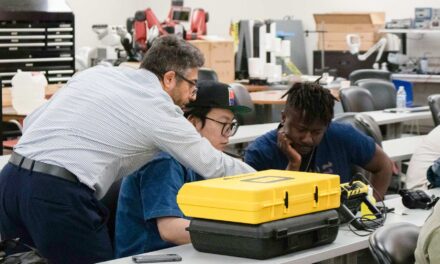
Engineering success: It’s all in the mind(set)
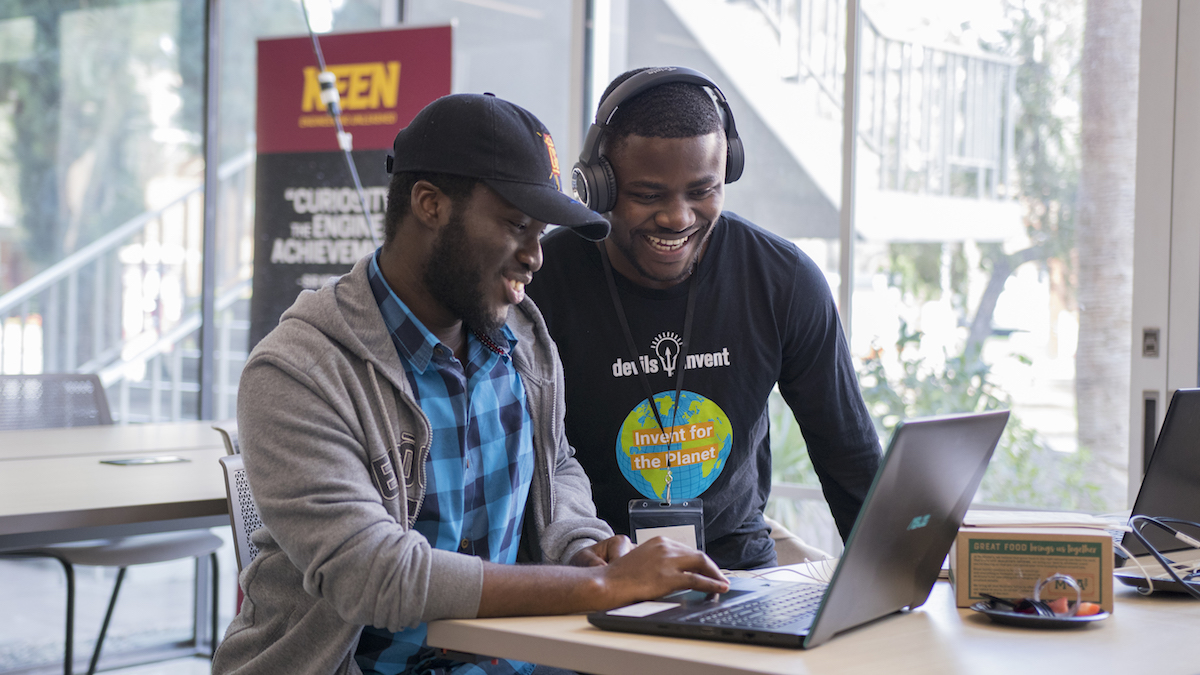
The right skills and the right mindset are both necessary for success.
Equipping engineers with technical skills means they can build something, but shifting their mindset can mean the products and processes they build will be useful to society.
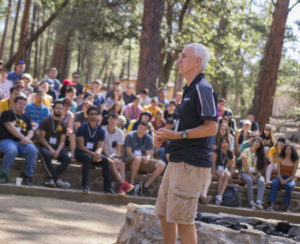
James Collofello, co-principal investigator on the Kern Family Foundation grant project, speaks to a group of incoming freshmen and student counselors at the E2 welcome event for new students. Photographer: Marco-Alexis Chaira/ASU
This is the goal of teaching the entrepreneurial mindset, a mission of the Kern Entrepreneurial Engineering Network, or KEEN. KEEN is a collaboration among 38 colleges and universities, including Arizona State University, focused on preparing engineering students to create personal, economic and societal value through purposeful careers.
In 2016, ASU received a $2.86 million grant from the Kern Family Foundation to further the entrepreneurial mindset — known as EM — in engineering education on a national scale. ASU’s Ira A. Fulton Schools of Engineering implemented the grant through a two-phase approach aiming to foster this mindset among students and faculty, provide instructor workshops and pilot a faculty mentorship program introducing EM as a teaching approach.
By 2019, the ASU initiative reached nearly 5,000 new students and chronicled 25 EM@ASU case studies where EM was fully and deeply integrated throughout the Fulton Schools curricular, co-curricular and extra-curricular programs.
“Progress on this project is going very well,” says James Collofello, professor of computer science and engineering, vice dean of Academic and Student Affairs and co-principal investigator of the Kern Family Foundation grant project. “Our plan is to institutionalize EM into all of our 17 ABET programs over the next two years.”
Giving students the mindset to make an impact
The entrepreneurial mindset encompasses the three C’s: curiosity, connections and creating value.
Curiosity leads to discoveries by investigating what’s out there, what works, what doesn’t and why. Students learn that a single piece of information isn’t useful on its own, so they must connect their discoveries with meaningful insights and innovative solutions. These steps lead to creating value by anticipating and meeting society’s needs.
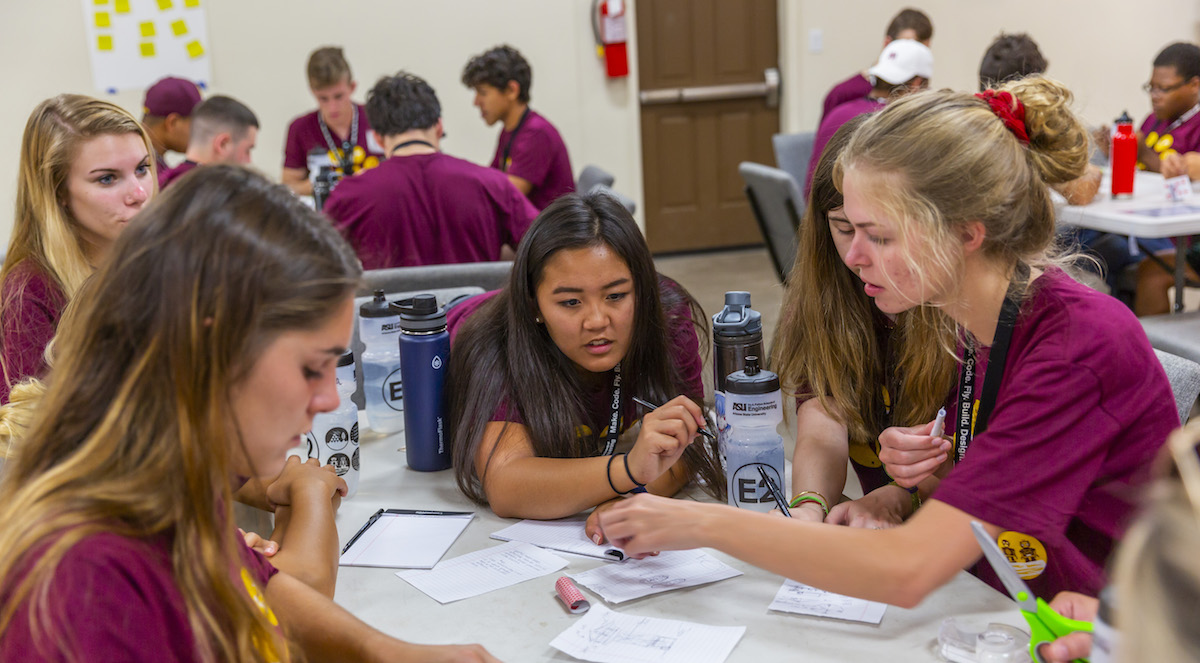
Students at the E2 first-year student welcome event participate in Sparky’s Vista, an activity introducing the entrepreneurial mindset and the three C’s to freshmen. An instructional video initiates the activity and includes an introductory message explaining the importance of EM within the Ira A. Fulton Schools of Engineering. Over the past three summers from 2016 through 2018, more than 4,900 students engaged in the Sparky’s Vista activity. Photographer: Jessica Hochreiter/ASU
“If you employ EM, you’ll be curious about what’s already out there, what worked in the past, what didn’t and why,” says Layla Reitmeier, the ASU Kern Grant project manager in the Fulton Schools. “You know why you’re creating something.”
The usefulness of EM isn’t limited to students who will go on to create their own startups. These skills are important to working in industry as well as making government, nonprofits and all types of community-based organizations more competitive.
Students who had embraced EM were encouraged to apply for special student and research mini-grants to support their work. Others were invited to become Entrepreneurial Catalysts. These exceptional students provide coaching to their peers through one-on-one appointments, workshops, presentations and events, as well as through partnering with faculty.
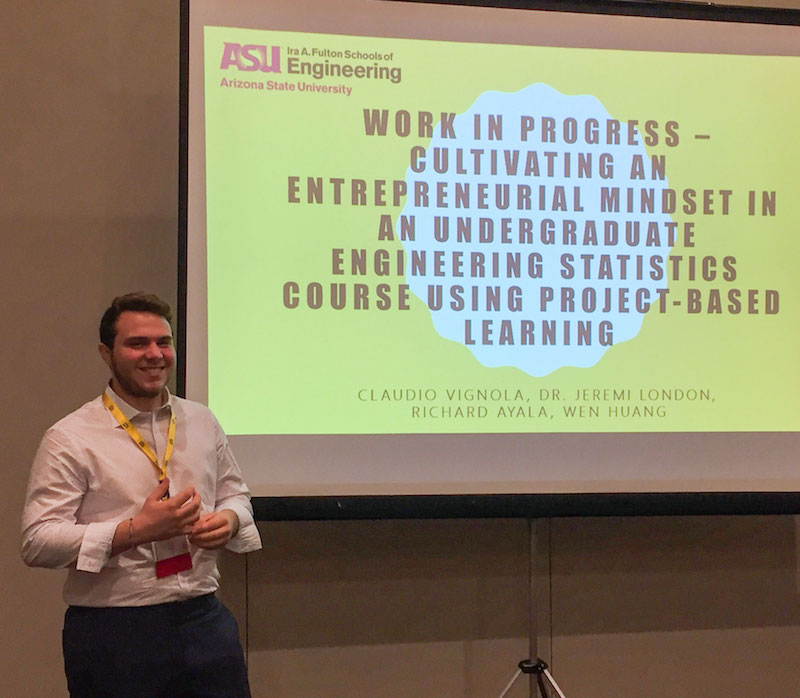
Robotics engineering student Claudio Vignola presents his entrepreneurial mindset research conducted with faculty member Jeremi London at the 2017 Frontiers of Education conference in Indianapolis. Vignola’s research involved developing new course curriculum and studying the outcome on student learning. Photo courtesy of Claudio Vignola
The concept of creating value inspired robotics engineering major Claudio Vignola to apply EM concepts in his projects and classes.
He worked with former Fulton Schools Assistant Professor Jeremi London to incorporate EM in an undergraduate statistics course.
While many engineering courses apply a project-based learning approach, math-intensive courses like engineering statistics do not. Vignola and London explored how project-based learning and applying an entrepreneurial mindset impacted students’ understanding of engineering statistics.
The course curriculum developed through their research tasked student teams with choosing an area of interest and getting funding to explore the effects of statistics on that field. They found that fostering a sense of curiosity, emphasizing the value of understanding statistics and demonstrating the ability to make connections influenced student success in the course.
Vignola and London published their work in IEEE Xplore. Vignola also presented their results at the 2017 Frontiers in Education conference in Indianapolis.
“It was terrifying at first,” says Vignola of the experience at FIE2017. “I was the only undergraduate student at the conference, which put a lot of pressure on me. But I can say it was fantastic that I got the opportunity to connect with many researchers in engineering education, many of whom are prestigious faculty from around the world.”
Empowering faculty to implement the entrepreneurial mindset in their classrooms
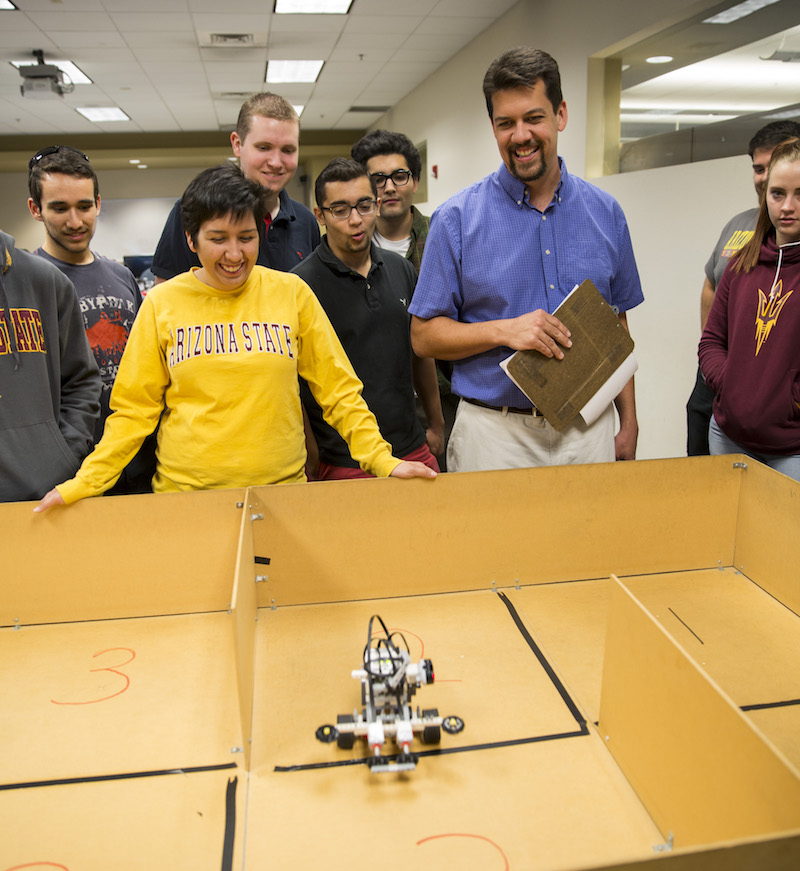
Lecturer Ryan Meuth (right) watches a demonstration of a robotics project with first-year computer science, engineering and informatics students in a FSE 100 introductory course. Meuth incorporates the Entrepreneurial Mindset and customer experience exercises in his introductory courses as well as senior-level capstone courses. Photographer: Cheman Cuan
To better incorporate the entrepreneurial mindset in engineering curriculums, faculty members were encouraged to submit proposals for KEEN Professorship mini-grants, which provided up to $12,000 to support development, implementation and dissemination of EM within their courses, programs or labs.
Thirty-three tenured and tenure-track faculty, lecturers and adjunct instructors received mini-grants, each proposing a different way to implement EM in their interactions with students.
Other faculty members were tasked with implementing EM in the introductory courses known as FSE 100 and capstone courses that wrap up a student’s undergraduate education.
Computer science, engineering and informatics Lecturer Ryan Meuth teaches both introductory and capstone courses where he has applied the customer discovery aspects of EM to his teaching approach.
In one of his FSE 100 introductory courses, Meuth tasks students with designing and building a one-eighth-scale robotic vehicle that can pick up and transport a passenger who uses a wheelchair. When students try to figure out the mechanics of their vehicle, Meuth asks them to consider how their decisions will affect the customer.
“It highlights the need to think about the customer experience when designing the solution to a problem,” Meuth says.
He has applied similar customer discovery elements to capstone classes through teaching Agile-based project management, a commonly used process in many industry teams. The Agile Mindset and the entrepreneurial mindset overlap in that they prioritize the customer experience.
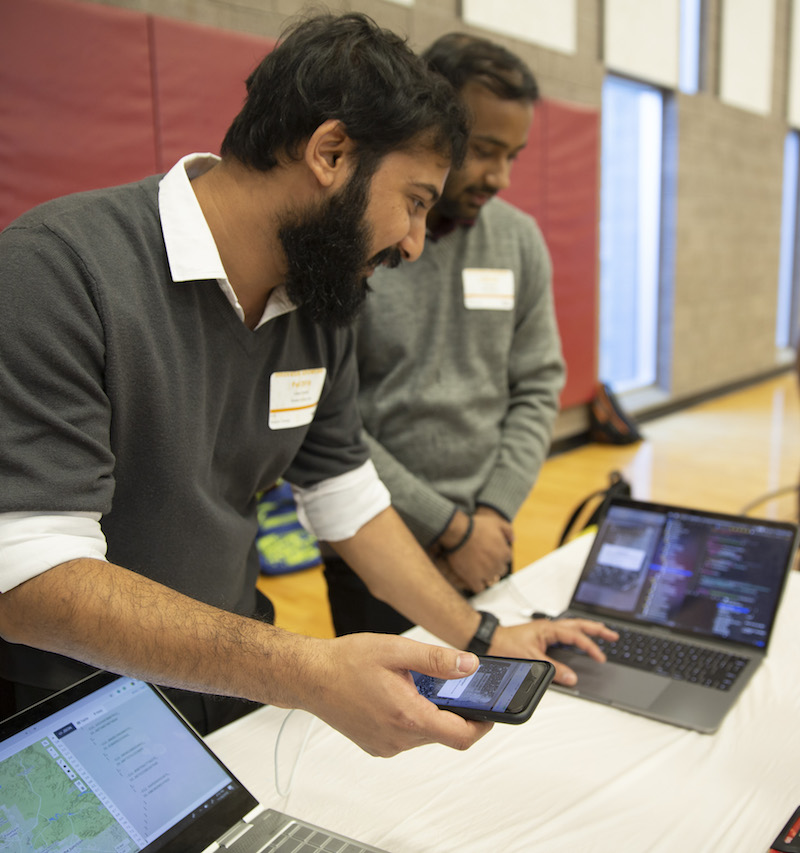
Engineering students demonstrate Hygiea, a user-friendly interface to help people identify and classify articles of trash, at the Innovation Showcase event where upper-division students demonstrate their projects. Hygiea is one example of an entrepreneurially minded student project. The Hygiea team has pitched its waste management system at student entrepreneur and innovation events and raised funding to create a useful product. Photographer: Erika Gronek/ASU
“The effort’s effect on project quality and sponsor satisfaction has been dramatic,” Meuth says. “I had tested using Scrum in one of my courses last semester, and it was such a success that I’ve rolled it out to all 14 of the capstone sections I’m supervising this spring.”
Going forward, he’s looking for more ways to develop EM content for the courses he teaches.
“I’m interested in learning more techniques and activities I can bring to my students,” Meuth says, “as well as sharing what has worked for me with the KEEN network.”
Expanding faculty mentorship opportunities
In May 2018, the Kern Family Foundation grant was renewed for another two-year period. This extension allows ASU’s KEEN project to implement its phase three goals: more broadly implementing and institutionalizing the entrepreneurial mindset among faculty members to reach more students, and sharing the ASU team’s findings with other KEEN network universities across the country.
“The Kern Family Foundation realizes that the way to reach more students is through faculty,” Reitmeier says. “And the way to take care of faculty is to support them through mentorship to understand EM so they can sustain this work.”
This wider-reaching approach takes the form of a faculty mentorship program. With the renewed grant, the Fulton Schools will study engineering faculty mentorship programs to determine programs that work and how to implement them effectively to create value for both the mentee and the university.
“It’s a very EM way of approaching how we can help mentor faculty,” Reitmeier says.
Meuth agrees that mentorship is a valuable part of the program.
“It’s the mentorship interaction and opportunity to collaborate [with the KEEN network] that communicates the true purpose, potential benefit and need for developing the entrepreneurial mindset in our students,” Meuth says.
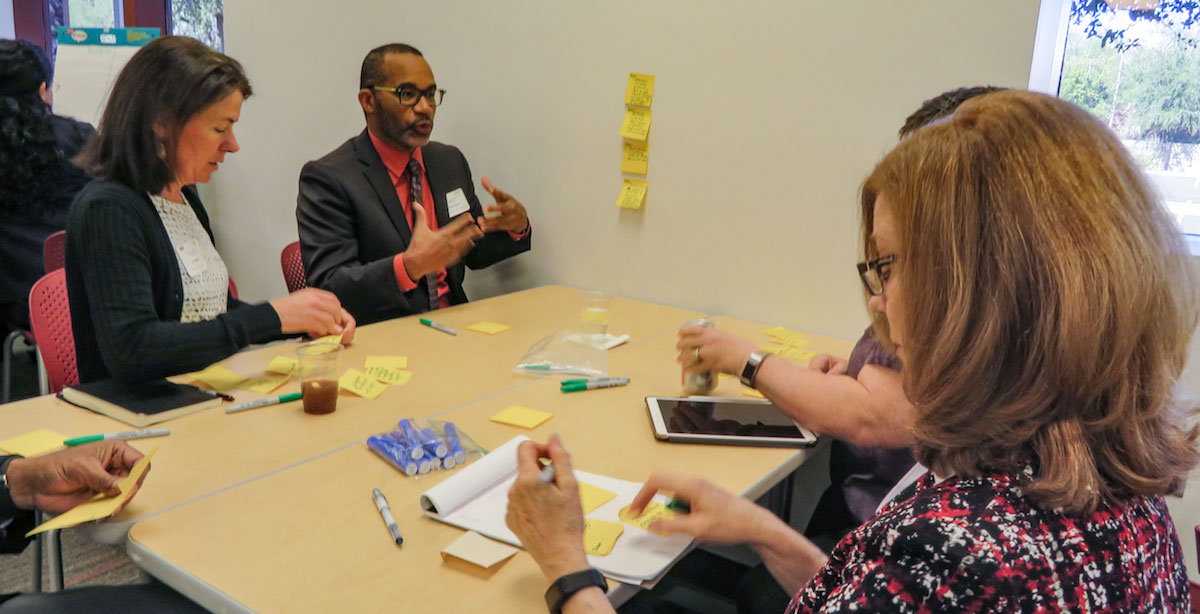
Ann McKenna (left), director of The Polytechnic School and co-principal investigator on the Kern Family Foundation grant project, works with engineering faculty at the ASU Convening on Engineering Faculty Mentorship Think Tank 2 in November. Faculty from universities nationwide discussed how the ASU Kern grant can assist in establishing partnerships to research and implement activities to support faculty mentorship. Photo courtesy of Layla Reitmeier
















